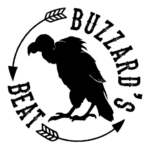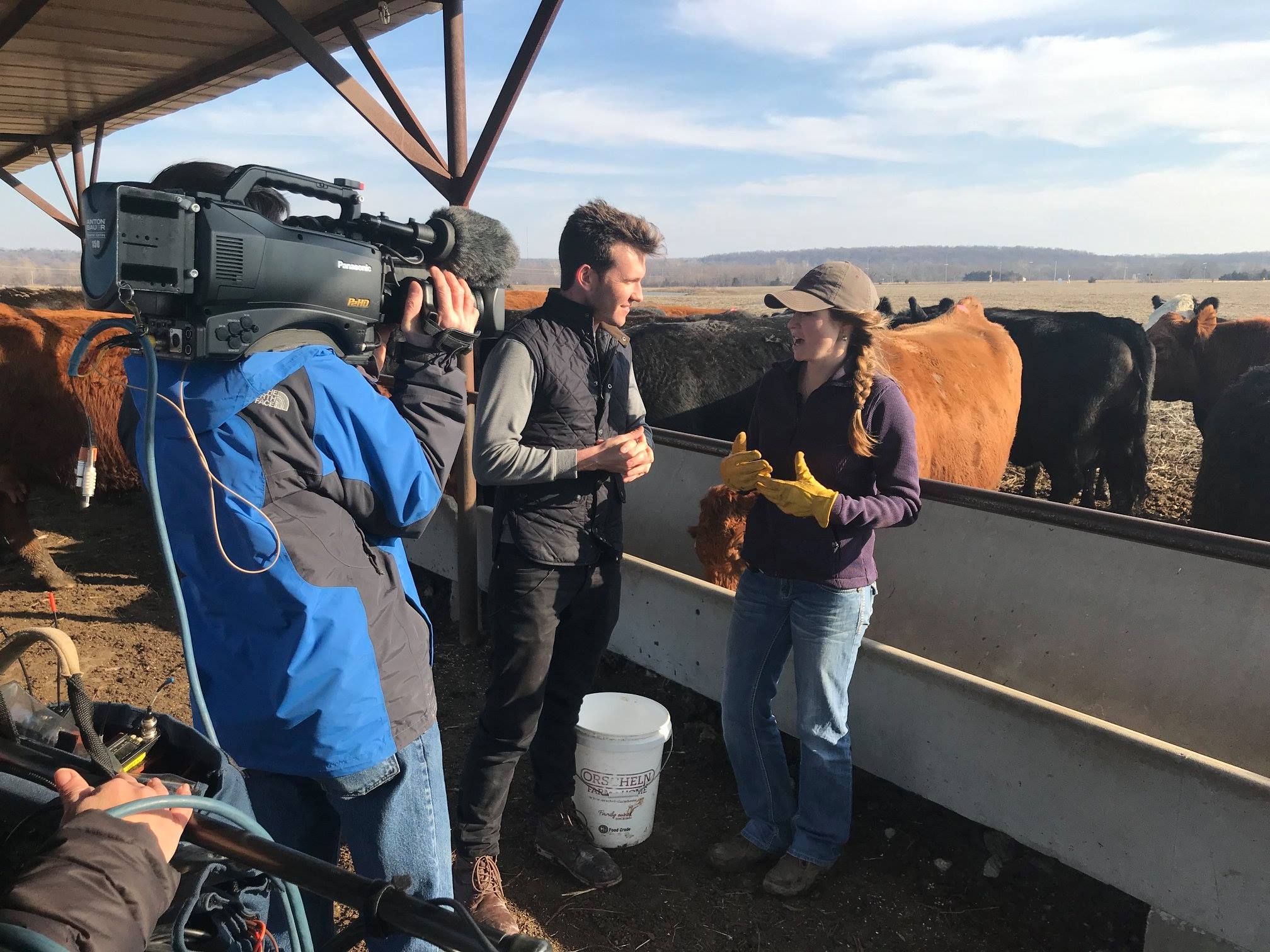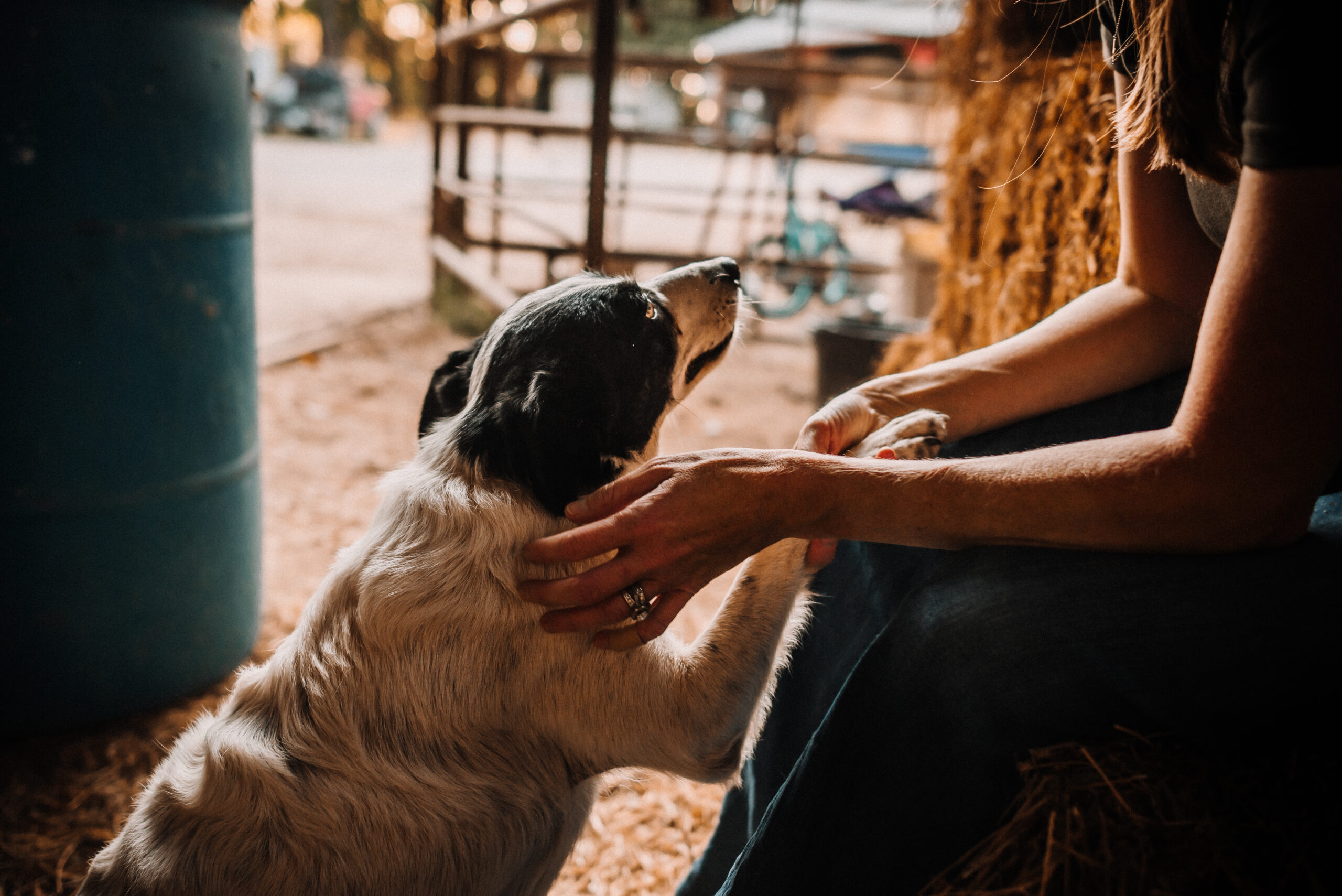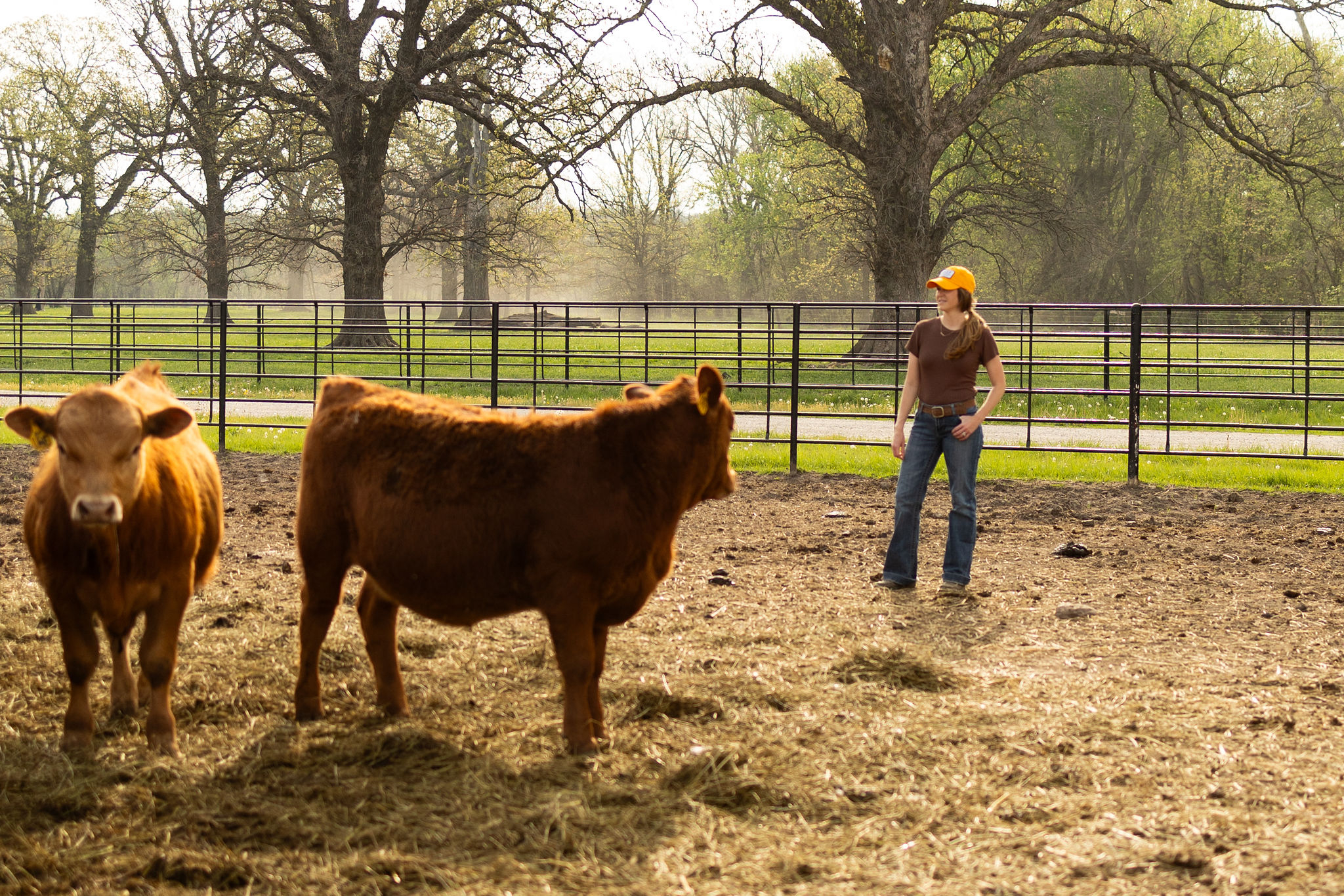If you’re new here, read on for a summary of the past few weeks in my life. If you’ve been following for a while, skip down about a half a page scroll and start reading there.
February 8 – Read the Green New Deal and FAQ – wrote letter and emailed to Congresswoman AOC; published on blog.
February 9 – Posted letter to Facebook; letter goes viral and crashes website intermittently for 48 hours.
February 10 – Letter gets attention and phone call from Kansas Congressman Marshall.
February 13 – MSNBC contacts me about an interview on our ranch.

Talking with Kailani Koenig about how we raise beef. Photo credit: Vaughn Hillyard
February 14 – MSNBC crew arrives at ranch; we brave the cold, wind and mud to talk about beef sustainability, feed by-products, food waste, genetics and much more. Scheduled to air February 15.
February 15 – National Emergency declared; interview air date pushed to February 18.
February 18 – Interview airs. Buzzard goes national.
February 20 – Podcast with Ag News Daily and interview with The Fence Post and new favorite hashtag discovered: #goBuzzardgo
February 21 to present day – multiple article interview requests, conversations with community members, jokes made about my TV debut.
March 8 – I appear on FOX & Friends speaking about beef sustainability and the letter receives another round of attention.
Summary: Buzzard = exhausted.
A lot has happened since that famous letter was published – no, I still haven’t heard from its inspiration – but perhaps the most valuable outcome is the chance to talk about cattle and their positive climate contributions on a national stage. However, there are a few things that didn’t make it over the air waves and I think there is some valuable information that still needs to have light shed on it.
Upcycling
One of my passion projects is food waste. During a different chapter of my career, I ideated, created and coordinated an industry-wide food waste challenge that prompted consumers (AKA all of us) to evaluate food purchasing and preparing habits and adjust in order to waste less food and make their shopping cart contents go further. I learned a lot during that challenge, including the fact that beef is one of the least-wasted foods in the grocery store. Shoppers view it as special (as they should) and are more likely to eat beef leftovers or clean their plates instead of scraping them into the trash.

This land is in a flood plain and isn’t suitable for growing anything else – but it does grow grass quite well which translates to beef.
Along the same lines, cows are excellent up-cyclers and recyclers. They are able to help reduce food waste just by eating. Cows consume food by-products that humans can’t (or won’t) eat and upcycle them into steaks, roasts and burgers. For example, in Kansas, Iowa, Missouri and other Midwestern states, we have access to distillers dried grains (DDGs) which are a by-product of ethanol production (a biofuel). DDGs are not suitable for human consumption but cows find them quite tasty. Another form of upcycling occurs when cows eat food stuffs such as sugar beet pulp, potato waste and peanut skins which are normally discarded but are palatable for cows. Another form of upcycling occurs from these new plant-based “meats.” These new products are made from wheat and potato protein and the process to extract these proteins leaves behind quite a bit of waste, (shocking, I know) which humans cannot eat but cattle can! Cattle eat by-products of other industries – fuel and food are just two examples – that would otherwise rot in a landfill. Cows really are the originally plant-based protein – taking plant waste and upcycling it into tasty steaks, roasts and burgers!
Carbon Farming
There are so many things that cows do well but something that often goes overlooked is their redistribution of carbon into the soil during grazing. The scientific name for this, carbon sequestration, is the long-term capture and storage of carbon from the atmosphere, typically as carbon dioxide. Basically, when cows are grazing in pastures – like they do for most of their lives – they are restoring carbon to the soil while simultaneously reducing greenhouse gas emissions and turning grass into nutritious beef for families like mine across the United States. Pastures and grasslands make up nearly 30% of U.S. land mass; avoiding the conversion of this land into tillable crop acreage can help prevent further greenhouse gas emissions.¹
In fact, according to Clint Rusk, chair of the Department of Animal Science at Oklahoma State University, enhancing carbon sequestration through properly managed cattle grazing practices can reduce the carbon footprint of beef dramatically. ¹
GHG emissions
Perhaps the most important piece of information that I feel compelled to share is U.S. government data from the Environmental Protection Agency, which shows cattle contribute less than 2% of greenhouse gas emissions nation-wide. I’ll say that again for the people in the back: less than 2% of GHG emissions in the US come from cattle.2 Transportation is responsible for almost 30% of US emissions.2 The emissions cows do give off, in the form of ‘burps’, is easily off-set by the positive impacts they have on soil health, food waste and carbon sequestration. So, if I were given the chance to be on MSNBC again, I hope to be able to share more information about all the great things that cows can do for our environment and climate change!
Before closing, I want to address some misconceptions about the MSNBC crew which are completely unwarranted and unfair.
I received so many comments from followers who, upon learning that I would be on MSNBC, felt it absolutely necessary to warn me about the malevolence that was sure to accompany this interview. Many people were certain that MSNBC was out to use subterfuge to get on my ranch and smear my name. “Too bad you couldn’t get on FOX News.” Consider this: who are we trying to reach here? Most of the people who are watching FOX News are a) probably eating beef anyway and b) agree that beef is sustainable. Is our goal to reach people that agree with us? I welcome the opportunity to speak with the older, urban Millennial parent that is more likely watching MSNBC, and I hope to be a resource for them. I challenge you to do the same.

Vaughn, Kai, Anna and Mike joined us for breakfast the next morning – we talked and laughed and watched a blizzard roll in! Photo credit: Vaughn Hillyard
Stop judging a book by its cover, or more appropriately, a news anchor by his/her affiliation.
I actually had someone tell me, after viewing the segment, that Vaughn Hillyard, the reporter, twisted my words. I was there. I know what I said – nothing was twisted and no foul play. Vaughn and his crew are welcome on our ranch anytime they want (except for July and August because it’s too hot to be outside during the day). They were genuine, kind people with no malicious intentions and I was proud to have them on the ranch and in our home.
Moving forward, I hope that my fellow Americans can find ways to come together and make actionable forward progress and not let a network name come between us and learning.
Until next time,
~ Buzzard ~
¹http://www.dasnr.okstate.edu/Members/donald-stotts-40okstate.edu/carbon-sequestration-a-positive-aspect-of-beef-cattle-grazing-grasslands
2 EPA. 2018. Inventory of U. S. Greenhouse Gas Emissions and Sinks: 1990-2016. U. S. Environmental Protection Agency, Washington, D. C.
P.S. If you wish to receive posts in your inbox automatically, sign up on the homepage in the right side pane. Furthermore, follow my ranch life activities on Instagram: @brandibuzzard.



